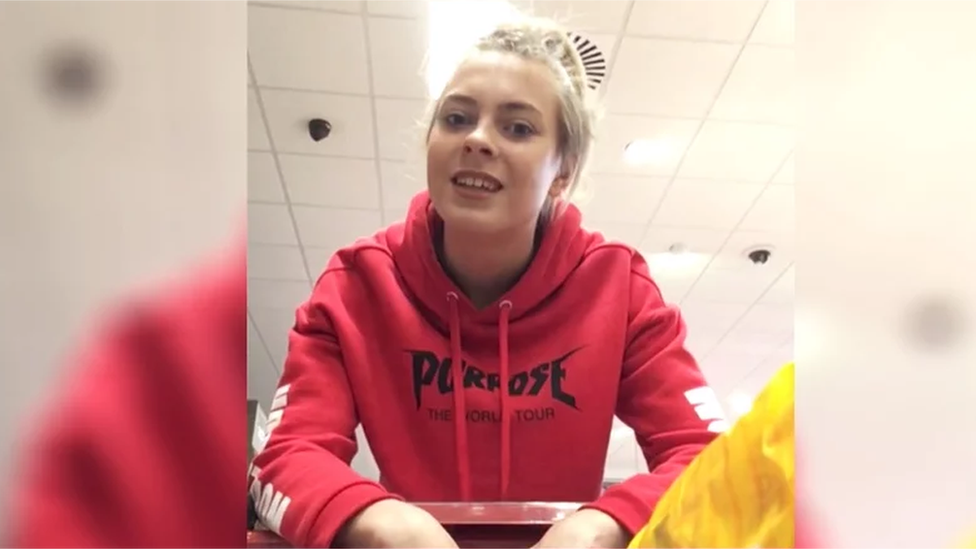Ana Kriégel: Who was the murdered 14-year-old schoolgirl?
- Published

Ana was a keen dancer and singer, often posting videos of her dancing on YouTube
Ana Kriégel was a 14-year-old schoolgirl originally from Russia who was murdered in May 2018.
Two boys, both 13 at the time, have been found guilty of her murder in an abandoned house in Lucan in Dublin. One of the boys was also convicted of sexual assault "involving serious violence".
Now 14, they could not be identified in court because of their age and were referred to simply as "Boy A" and "Boy B".
The six-week trial at Dublin's Central Criminal Court was heard by Mr Justice Paul McDermott and a jury of eight men and four women, who deliberated for 14 hours and 25 minutes before reaching their verdicts.
Both boys had pleaded not guilty to the charges.
Who was Ana Kriégel?
Ana was born in Russia in February 2004, and at the age of two was adopted by Irish woman Geraldine Kriégel and her French-born husband, Patric, who lived in Lucan.
She was a keen dancer and singer, practising for hours in her bedroom and often posting videos of her dancing on YouTube.
She was in many ways a typical teenage girl, who loved to listen to music, wear fake nails and use her various social media accounts.

Ana's parents described her as a happy child
At 5ft 8in (1.7m), she was tall and strong, being described by her mother as a "typical Siberian": she was a strong swimmer and gymnast.
But she also suffered horrific bullying and was targeted on social media in the months leading up to her death in May 2018.
On the first day of the murder trial Mrs Kriégel told the court her daughter was very vulnerable and, despite looking older than her 14 years, she was a "child on the inside".
"She was very immature. She looked so much older, but inside she was younger, far younger than her youth," said Mrs Kriégel.
Although she tried many times, Ana struggled to mix with other children.
"She was trying to make friends all the time. She spent a lot of time at the house, she loved her family and was happy at home," she added.
"It would have been nice for her to have a best friend."
'Happy child'
Patric Kriégel, a retired lecturer originally from Paris, spent a lot of his free time with Ana, doing school runs and preparing her lunch.
"Her primary years were very happy years," he said. "She was a very happy child."
But after starting secondary school Ana became stressed, which her father said was not like her.
"She would come home and tell stories and they were not happy stories," he said.
"They were calling her weird. Some people did not understand her. She was herself. She was full of fun.
"She couldn't hate anyone even though some of these people were bullying her.
"She was disappointed in people, in how they reacted to her.
"She would try and make friends. She was impulsive and might say the wrong thing. She was a teenager."

Ana's parents Geraldine and Patric Kriégel hugged and wept in court when the verdict was delivered
Mrs Kriégel struggled to hold back tears as she described waking Ana up for school on the morning of her disappearance.
"I kissed her goodbye," she said.
It was the last time she saw her daughter alive.
Wider public debate
The case has captured much of the public's attention in the Republic of Ireland, reviving memories of two-year-old Jamie Bulger who was murdered on Merseyside by two 10-year-old boys in 1993.
In the aftermath of the Bulger case, there was a debate in Britain about underage crime and its proper punishment.
It also raised questions as to whether the killers had been influenced by events in wider society such as "video nasties" - films containing potentially disturbing content that were not regulated due to a loop-hole in film classification laws in the 1980s.
In the wake of Ana Kriégel's murder, a similar debate could be sparked in the Republic of Ireland, where video nasties have now seemingly been replaced by the use of social medial on mobile phones by teenagers.
- Published18 June 2019

- Published17 May 2018
